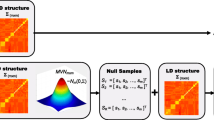Abstract
In genetic association studies, for each underlying genetic model, there is an optimal test. Usually, the true model is unknown, but knowledge from previous genome-wide association studies for the disease under investigation is available and provides information about the underlying model. We study how to incorporate this prior information about plausible genetic models to achieve better efficiency robustness in genetic association studies. Two procedures are proposed and studied. The first one reduces the set of genetic models using the prior information. The second one derives posterior probabilities for the plausible genetic models using trend tests. Then the trend test based on the posterior mean of the genetic model or a weighted trend test over various genetic models can be employed, similar in spirit to the efficiency robustness approach. In the proposed procedures, the strong Hardy–Weinberg disequilibrium in cases is studied. Simulations are conducted to compare the proposed methods with existing ones. The usefulness of the results for the analysis of data collected in replication studies is investigated, the proposed methods are shown to have better overall performance than existing one, and the methods are applied to analyze the real data.





Similar content being viewed by others
References
Freidlin, B., Podgor, M.J. and Gastwirth, J.L. (1999), Efficiency Robust Tests for Survival or Ordered Categorical Data. Biometrics 55, 883–886.
Freidlin, B., Zheng, G., Li, Z. and Gastwirth, J.L. (2002), “Trend tests for case-control studies of genetic markers: power, sample size and robustness,” Hum Hered, 53, 146–152.
Gastwirth, J.L. (1985), “The use of maximin efficiency robust tests in combining contingency tables and survival analysis,”. J Am Stat Assoc, 80, 380–384.
Johnson, V.E. (2005), “Bayes factors based on test statistics,” J Roy Stat Soc Ser B, 67, 689–701.
——— (2008), “Properties of Bayes factors based on test statistics,” Scand J Stat, 35, 354–368.
Kass, R. and Raftery, A. (1995), “Bayes factors,” J Am Stat Assoc, 90, 773–795.
Klein, R.J., Zeiss, C., Chew, E.Y., Tsai, J.Y., Sackler, R.S., Haynes, C., Henning, A.K., SanGiovanni, J.P., Mane, S.M., Mayne, S.T., Bracken, M.B., Ferris, F.L., Ott, J., Barnstable, C., Hoh, J. (2005), “Complement factor H polymorphism in aged-related macular degeneration,” Science, 308, 385–389.
Li, Q., Zheng, G., Li, Z. and Yu, K. (2008), “Efficient approximation of p-value of the maximum of correlated tests, with applications to genome-wide association studies,” Ann Hum Genet, 72, 397–406.
Nature Genetics. (1999), “Editorial: Freely associating,” Nature Genetics, 22, 1–2.
NCI-NHGRI. (2007), “Replicating genotype-phenotype associations,” Nature 447, 655-660.
Pandey, J.P. and Frederick, M. (2002), “TNF-K, IL1-L, and immunoglobulin (GM and KM) gene polymorphisms in sarcoidosis,” Hum Immun 63, 485–491.
Seaman, S. and Richardson, S. (2004), “Equivalence of prospective and retrospective models in the Bayesian analysis of case-control studies,” Biometrika, 91, 15–25.
Sasieni, P.D. (1997), “From genotypes to genes: Doubling the sample size,” Biometrics, 53, 1253–1261.
Price, A.L., Patterson, N.J., Plenge, R.M., Weinblatt, M.E., Shadick, N.A. and Reich, D. (2006). Principal components analysis corrects for stratification in genome-wide association studies, Nat Genet, 38, 904C909.
Sladek, R., Rocheleau, G., Rung, J., Dina, C., Shen, L., Serre, D., Boutin, P., Vincent, D., Belisle, A., Hadjadj, S., Balkau, B., Heude, B., Charpentier, G., Hudson, T.J., Montpetit, A., Pshezhetsky, A.V., Prentki, M., Posner, B.I., Balding, D.J., Meyre, D., Polychronakos, C. and Froguel, P. (2007), “A genome-wide association study identifies novel risk loci for type 2 diabetes,” Nature, 445, 881–885.
Song, K. and Elston, R.C. (2006), “A powerful method of combining measures of association and Hardy-Weinberg disequilibrium for fine-mapping in case-control studies,” Stat Med, 25, 105–126.
The Wellcome Trust Case Control Consortium (WTCCC). (2007), “Genome-wide association study of 14,000 cases of seven common diseases and 3,000 shared controls,” Nature, 447, 661–678.
Vukcevic, D., Hechter, E., Spencer, C. and Donnelly, P. (2011) “Disease model distortion in association studies.” Genetic epidemiology 35, 278–290.
Weir, B.S. (1996), “Genetic Data Analysis II: Methods for Discrete Population Genetic Data”, Sunderland, MA: Sinauer Associations Inc.
Wittke-Thompson, J.K., Pluzhnikov, A. and Cox, N.J. (2005), “Rational inferences about departure from Hardy-Weinberg equilibrium,” Am J Hum Genet, 76, 967–986.
Xu, J., Yuan, A. and Zheng, G. (2012), “Bayes factor based on the trend test incorporating HardyWeinberg disequilibrium: more power to detect genetic association,” Ann Hum Genet, 76, 301–311.
Zang, Y., Fung, W.K. and Zheng, G. (2010), “Simple algorithms to calculate asymptotic null distributions of robust tests in case-control genetic association studies in R,” J Stat Software 33, Issue 8.
Zheng, G., Freidlin, B. and Gastwirth, J.L. (2006). Comparison of Robust Tests for Genetic Association Using Case Control Studies. IMS Lecture Notes-Monograph Series. 49, 253–265.
Zheng, G. and Ng, H.K.T. (2008), “Genetic model selection in two-phase analysis for case-control association studies,” Biostatistics, 9, 391–399.
Zheng, G., Xu, J., Yuan, A. and Wu, C.O. (2013), “Impact on modes of inheritance and relative risks using extreme sampling when designing genetic association studies,” Ann Hum Genet, 77, 80–84.
Acknowledgments
Q. Li was supported in part by the National Science Foundation of hina (Grant No. 11371353, 61134013) and the Breakthrough Project of Strategic Priority Program of the Chinese Academy of Sciences, Grant No. XDB13040600.
Author information
Authors and Affiliations
Corresponding author
Rights and permissions
About this article
Cite this article
Zheng, G., Zhang, W., Li, Q. et al. Analysis of Genetic Association Studies Incorporating Prior Information of Genetic Models. JABES 20, 173–191 (2015). https://doi.org/10.1007/s13253-015-0200-y
Received:
Accepted:
Published:
Issue Date:
DOI: https://doi.org/10.1007/s13253-015-0200-y




